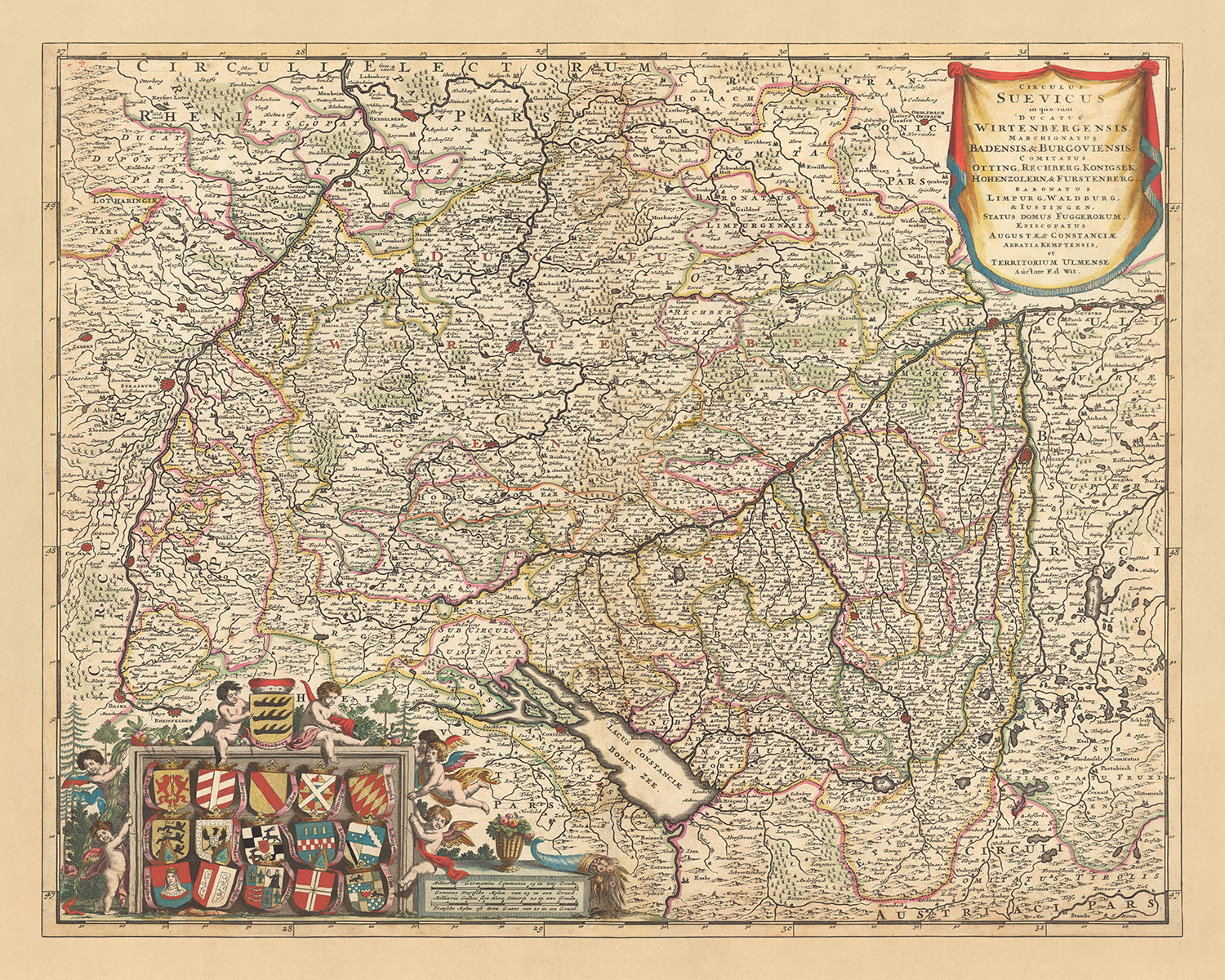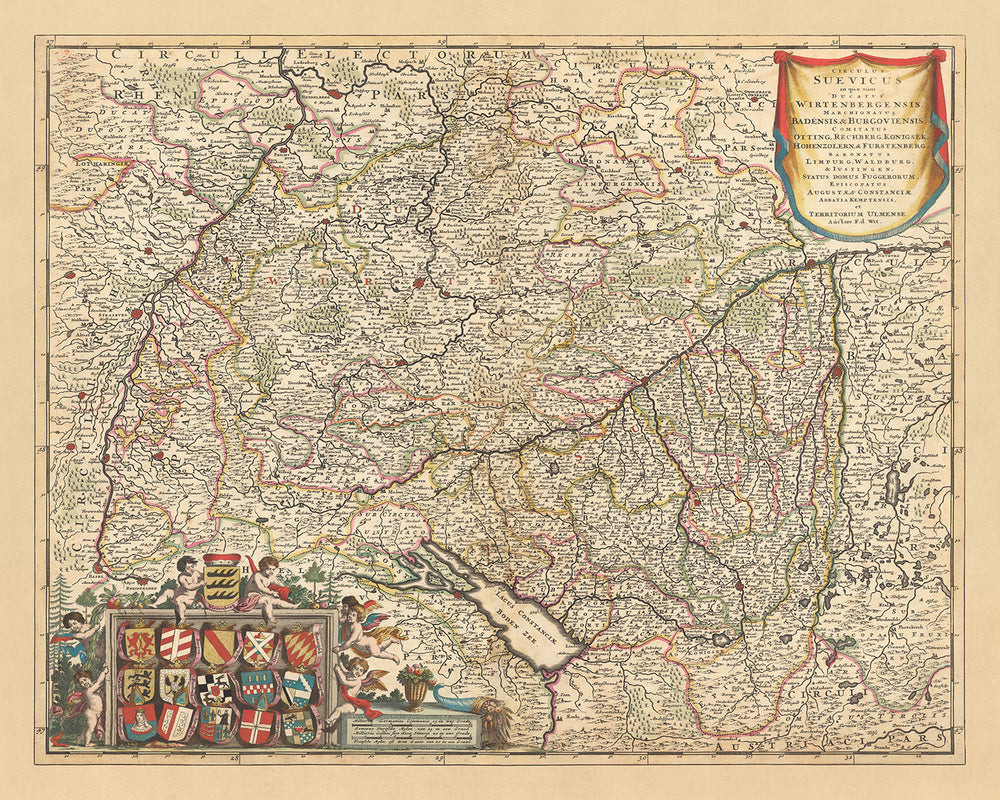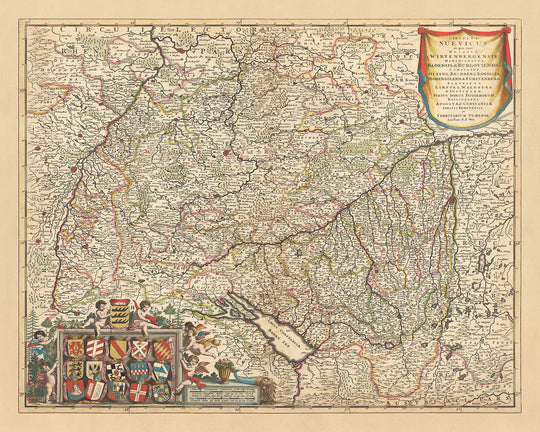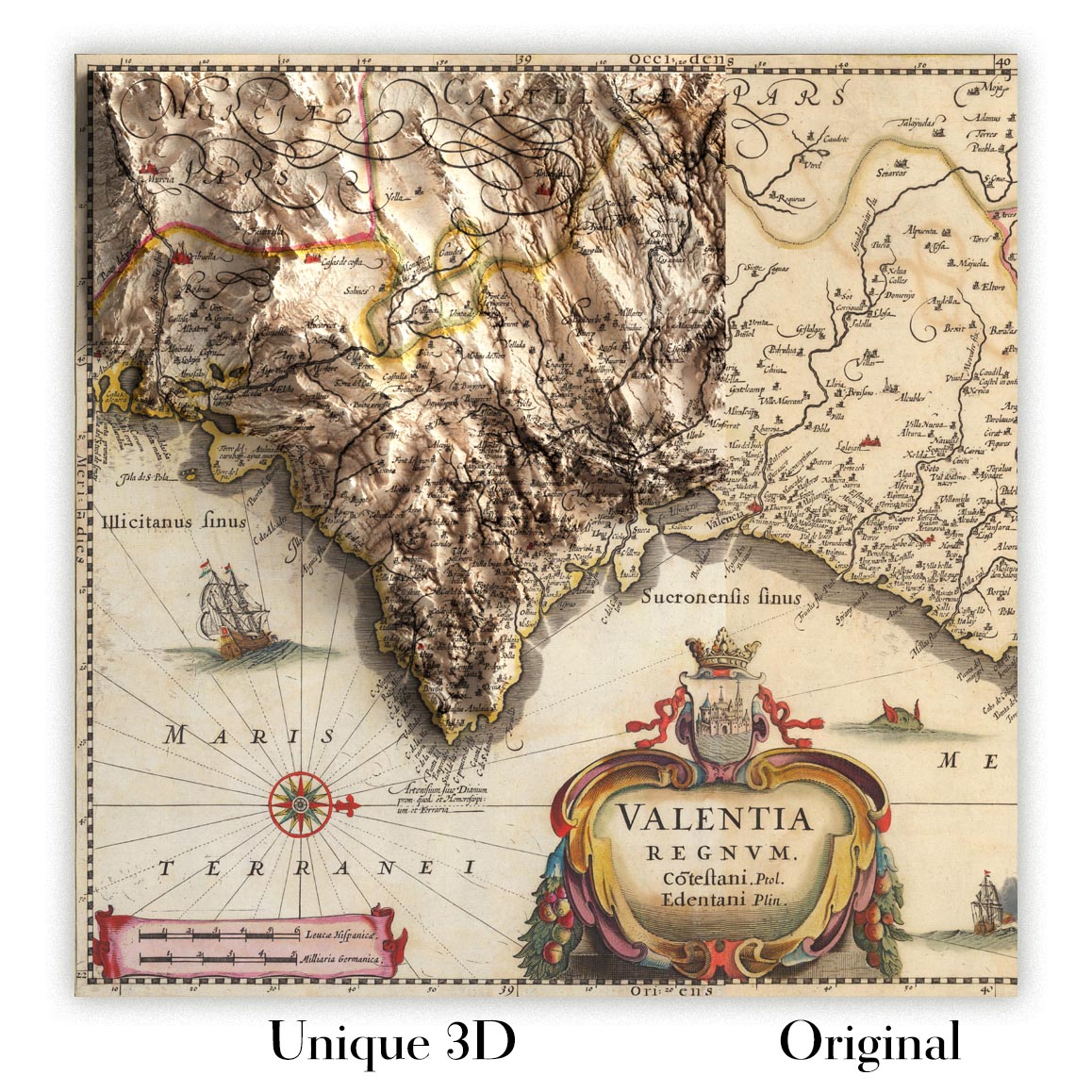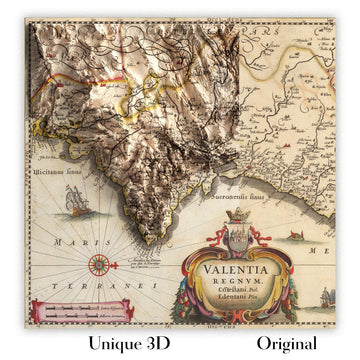- Handmade locally. No import duty or tax
- FREE Delivery. Arrives in 2-3 days
- Love it or your money back
- Questions? WhatsApp me any time
Own a piece of history
5,000+ 5 star reviews


Immerse yourself in the intricate details of this remarkable 1690 map of the Swabian Circle, meticulously crafted by the renowned mapmaker Nicolaes Visscher II. This remarkable piece of history showcases not only the geographical prowess of the Dutch Golden Age, but also the political and cultural landscapes of the time. The Swabian Circle, known as 'Circulus Suevicus' in Latin, was an important Imperial Circle of the Holy Roman Empire, encompassing much of what is now modern-day southern Germany.
The map's full Latin title, 'Circulus Suevicus in quo sunt Ducatus Wirtenbergensis, Marchionatus Badensis et Burgoviensis Comitatus Otting et Territorium Ulmense', translates to 'Swabian Circle in which are the Duchy of Württemberg, the Margraviate of Baden and Burgau, the County of Oettingen, and the Territory of Ulm'. This title aptly describes the political divisions of the region during the late 17th century.
Highlighted on this map are five key cities: Stuttgart, Mannheim, Augsburg, Karlsruhe, and Strasbourg. Stuttgart, the capital of the Duchy of Württemberg, was a significant political and cultural hub. Mannheim, located in the Margraviate of Baden, was known for its architectural innovations. Augsburg, a Free Imperial City, was a vibrant center of trade and industry. Karlsruhe, although not yet the city we know today, was part of the Margraviate of Baden. Strasbourg, an important city within the Holy Roman Empire, was a nexus of politics, culture, and commerce.
The map also offers a fascinating glimpse into the geographical features of the region. The undulating terrain, the coursing rivers, and the strategic positioning of cities and towns all speak to the rich tapestry of life in the Swabian Circle. This map is not just a geographical representation, but a window into the past, providing a sense of the political divisions, cultural landmarks, and natural phenomena that shaped this significant region in the late 17th century.
Some of the significant locations shown on this map:
Duchy of Württemberg
- Stuttgart - Known as 'Stuotgarten' in the Middle Ages, it was the capital of the Duchy of Württemberg and a significant political and cultural hub.
- Ludwigsburg - Founded in 1704, it was known for its Baroque architecture and palace.
- Tübingen - A university town since 1477, it was known for its intellectual and cultural contributions.
- Reutlingen - Known as 'Reutlinga' in the Middle Ages, it was a free imperial city until it was annexed by Württemberg in 1802.
- Heilbronn - Known for its wine trade, it was a free imperial city until it was annexed by Württemberg in 1803.
Margraviate of Baden
- Mannheim - Known for its architectural innovations, it was a significant city within the Margraviate of Baden.
- Karlsruhe - Although not yet the city we know today, it was part of the Margraviate of Baden.
- Baden-Baden - Known for its thermal baths, it was a popular destination for European nobility.
- Freiburg - Founded in 1120, it was known for its university and Minster, a medieval church.
- Pforzheim - Known as the 'Gateway to the Black Forest', it was a significant city within the Margraviate of Baden.
County of Oettingen
- Oettingen - The seat of the County of Oettingen, it was known for its castle and Renaissance architecture.
- Nördlingen - Known for its well-preserved medieval architecture, it was a significant city within the County of Oettingen.
- Harburg - Known for its castle, it was a significant city within the County of Oettingen.
- Mörnsheim - Known for its baroque church, it was a significant city within the County of Oettingen.
- Wemding - Known for its historic town center, it was a significant city within the County of Oettingen.
Territory of Ulm
- Ulm - Known for its Minster, the tallest church in the world, it was a significant city within the Territory of Ulm.
- Neu-Ulm - Although not yet the city we know today, it was part of the Territory of Ulm.
- Blaubeuren - Known for its abbey, it was a significant city within the Territory of Ulm.
- Ehingen - Known for its beer, it was a significant city within the Territory of Ulm.
- Laupheim - Known for its castle, it was a significant city within the Territory of Ulm.
Notable Boundaries and Natural Phenomena
- Rhine River - A significant waterway in Europe, it forms part of the western boundary of the map.
- Black Forest - Known for its dense, evergreen forests and picturesque villages, it is a popular tourist destination today.
- Swabian Jura - A mountain range in Baden-Württemberg, it is known for its hiking trails and caves.
- Lake Constance - The third largest lake in Central Europe, it forms part of the southern boundary of the map.
- Danube River - The second longest river in Europe, it flows through multiple cities on the map.
Notable Historical Events (1600-1690)
- Thirty Years' War (1618-1648) - A devastating conflict that resulted in significant changes in the political landscape of the Holy Roman Empire.
- Peace of Westphalia (1648) - The series of treaties that ended the Thirty Years' War and redefined the political boundaries of Europe.
- The Great Turkish War (1683-1699) - Although not directly impacting the region, the war had significant implications for the balance of power in Europe.
Please double check the images to make sure that a specific town or place is shown on this map. You can also get in touch and ask us to check the map for you.
This map looks great at all sizes: 12x16in (30.5x41cm), 16x20in (40.5x51cm), 18x24in (45.5x61cm), 24x30in (61x76cm), 32x40in (81.5x102cm), 40x50in (102x127cm), 48x60in (122x153cm) and 56x70in (142x178cm), but it looks even better when printed large.
I can create beautiful, large prints of this map up to 90in (229cm). Please get in touch if you're looking for larger, customised or different framing options.
The model in the listing images is holding the 16x20in (40.5x51cm) version of this map.
The fifth listing image shows an example of my map personalisation service.
If you’re looking for something slightly different, check out my collection of the best old maps of Europe and European cities to see if something else catches your eye.
Please contact me to check if a certain location, landmark or feature is shown on this map.
This would make a wonderful birthday, Christmas, Father's Day, work leaving, anniversary or housewarming gift for someone from the areas covered by this map.
This map is available as a giclée print on acid free archival matte paper, or you can buy it framed. The frame is a nice, simple black frame that suits most aesthetics. Please get in touch if you'd like a different frame colour or material. My frames are glazed with super-clear museum-grade acrylic (perspex/acrylite), which is significantly less reflective than glass, safer, and will always arrive in perfect condition.
This map is also available as a float framed canvas, sometimes known as a shadow gap framed canvas or canvas floater. The map is printed on artist's cotton canvas and then stretched over a handmade box frame. We then "float" the canvas inside a wooden frame, which is available in a range of colours (black, dark brown, oak, antique gold and white). This is a wonderful way to present a map without glazing in front. See some examples of float framed canvas maps and explore the differences between my different finishes.
For something truly unique, this map is also available in "Unique 3D", our trademarked process that dramatically transforms the map so that it has a wonderful sense of depth. We combine the original map with detailed topography and elevation data, so that mountains and the terrain really "pop". For more info and examples of 3D maps, check my Unique 3D page.
For most orders, delivery time is about 3 working days. Personalised and customised products take longer, as I have to do the personalisation and send it to you for approval, which usually takes 1 or 2 days.
Please note that very large framed orders usually take longer to make and deliver.
If you need your order to arrive by a certain date, please contact me before you order so that we can find the best way of making sure you get your order in time.
I print and frame maps and artwork in 23 countries around the world. This means your order will be made locally, which cuts down on delivery time and ensures that it won't be damaged during delivery. You'll never pay customs or import duty, and we'll put less CO2 into the air.
All of my maps and art prints are well packaged and sent in a rugged tube if unframed, or surrounded by foam if framed.
I try to send out all orders within 1 or 2 days of receiving your order, though some products (like face masks, mugs and tote bags) can take longer to make.
If you select Express Delivery at checkout your order we will prioritise your order and send it out by 1-day courier (Fedex, DHL, UPS, Parcelforce).
Next Day delivery is also available in some countries (US, UK, Singapore, UAE) but please try to order early in the day so that we can get it sent out on time.
My standard frame is a gallery style black ash hardwood frame. It is simple and quite modern looking. My standard frame is around 20mm (0.8in) wide.
I use super-clear acrylic (perspex/acrylite) for the frame glass. It's lighter and safer than glass - and it looks better, as the reflectivity is lower.
Six standard frame colours are available for free (black, dark brown, dark grey, oak, white and antique gold). Custom framing and mounting/matting is available if you're looking for something else.
Most maps, art and illustrations are also available as a framed canvas. We use matte (not shiny) cotton canvas, stretch it over a sustainably sourced box wood frame, and then 'float' the piece within a wood frame. The end result is quite beautiful, and there's no glazing to get in the way.
All frames are provided "ready to hang", with either a string or brackets on the back. Very large frames will have heavy duty hanging plates and/or a mounting baton. If you have any questions, please get in touch.
See some examples of my framed maps and framed canvas maps.
Alternatively, I can also supply old maps and artwork on canvas, foam board, cotton rag and other materials.
If you want to frame your map or artwork yourself, please read my size guide first.
My maps are extremely high quality reproductions of original maps.
I source original, rare maps from libraries, auction houses and private collections around the world, restore them at my London workshop, and then use specialist giclée inks and printers to create beautiful maps that look even better than the original.
My maps are printed on acid-free archival matte (not glossy) paper that feels very high quality and almost like card. In technical terms the paper weight/thickness is 10mil/200gsm. It's perfect for framing.
I print with Epson ultrachrome giclée UV fade resistant pigment inks - some of the best inks you can find.
I can also make maps on canvas, cotton rag and other exotic materials.
Learn more about The Unique Maps Co.
Map personalisation
If you're looking for the perfect anniversary or housewarming gift, I can personalise your map to make it truly unique. For example, I can add a short message, or highlight an important location, or add your family's coat of arms.
The options are almost infinite. Please see my map personalisation page for some wonderful examples of what's possible.
To order a personalised map, select "personalise your map" before adding it to your basket.
Get in touch if you're looking for more complex customisations and personalisations.
Map ageing
I have been asked hundreds of times over the years by customers if they could buy a map that looks even older.
Well, now you can, by selecting Aged before you add a map to your basket.
All the product photos you see on this page show the map in its Original form. This is what the map looks like today.
If you select Aged, I will age your map by hand, using a special and unique process developed through years of studying old maps, talking to researchers to understand the chemistry of aging paper, and of course... lots of practice!
If you're unsure, stick to the Original colour of the map. If you want something a bit darker and older looking, go for Aged.
If you are not happy with your order for any reason, contact me and I'll get it fixed ASAP, free of charge. Please see my returns and refund policy for more information.
I am very confident you will like your restored map or art print. I have been doing this since 1984. I'm a 5-star Etsy seller. I have sold tens of thousands of maps and art prints and have over 5,000 real 5-star reviews. My work has been featured in interior design magazines, on the BBC, and on the walls of dozens of 5-star hotels.
I use a unique process to restore maps and artwork that is massively time consuming and labour intensive. Hunting down the original maps and illustrations can take months. I use state of the art and eye-wateringly expensive technology to scan and restore them. As a result, I guarantee my maps and art prints are a cut above the rest. I stand by my products and will always make sure you're 100% happy with what you receive.
Almost all of my maps and art prints look amazing at large sizes (200cm, 6.5ft+) and I can frame and deliver them to you as well, via special oversized courier. Contact me to discuss your specific needs.
Or try searching for something!







